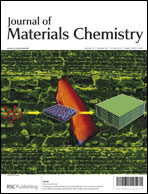New alkyloxyphenyl substituted pyrazolium salts [H2pzR(n)][A] (R(n) = C6H4OCnH2n+1; n = 8, 10, 12, 14, 16, 18; [A] = Cl−, BF4−, ReO4−, SbF6−, CF3SO3−, CH3-p-C6H4SO3−) have been synthesised and characterised. Those containing Cl−, BF4−, ReO4− and SbF6− anions behave as liquid crystal compounds exhibiting smectic A (SmA) mesophases. Because the precursor neutral pyrazoles [HpzR(n)] were not liquid crystals, their protonation and strategic choice of the counter-anion was found useful to achieve mesomorphism and to modulate the transition temperatures, so giving rise to a new class of ionic liquid crystals. The X-ray crystal structures of selected derivatives as representative examples of each type of compound have been resolved. In most of the cases, for X-ray purposes, the salts were designed to contain one methoxyphenyl-substituted pyrazolium cation. Different structural features have been found depending on the nature of the anion. Dimeric units held through hydrogen bonds are arranged in chains which pack in a layer-like array for compounds [H2pzR(10)][BF4], [H2pzR(1)][OTf] and [H2pzR(1)][PTS], but 2D structures were found for [H2pzR(1)][Cl] and [H2pzR(1)][ReO4]. Relationships between the solid and the mesophase structures are proposed. The absence of mesomorphism for CF3SO3− and CH3-p-C6H4SO3− derivatives is also explained on the basis of the main structural features.


 Please wait while we load your content...
Please wait while we load your content...